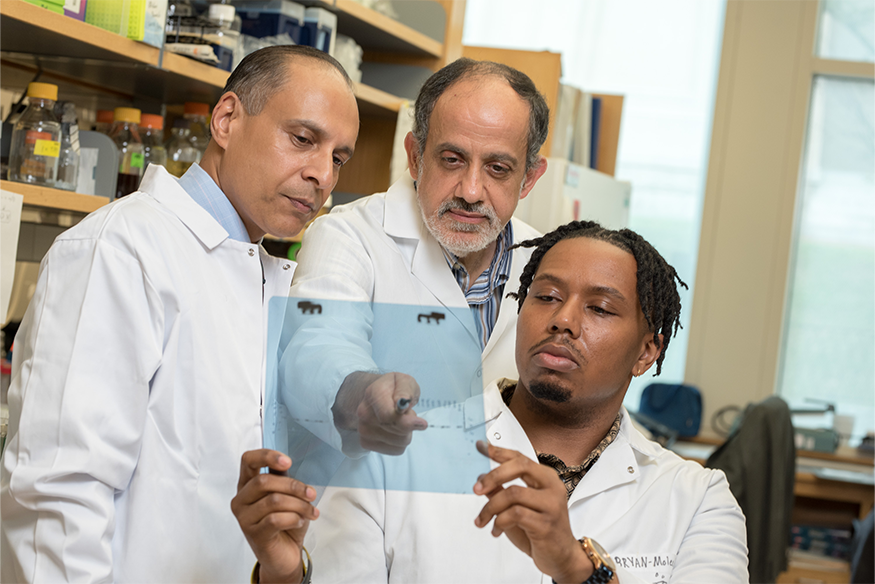Latest News
Research & Innovation
Targeted strategy prevents untreatable nerve pain caused by chemotherapy
May 28, 2025
 Devanand Sarkar, MBBS, Ph.D., M. Imad Damaj, Ph.D., and Bryan McKiver, M.S., Ph.D., published research that is the first to suggest that a tumor-driving gene known as AEG-1 actively regulates the inflammation responsible for causing chemotherapy-induced peripheral neuropathy.
Devanand Sarkar, MBBS, Ph.D., M. Imad Damaj, Ph.D., and Bryan McKiver, M.S., Ph.D., published research that is the first to suggest that a tumor-driving gene known as AEG-1 actively regulates the inflammation responsible for causing chemotherapy-induced peripheral neuropathy.
New research out of VCU Massey Comprehensive Cancer Center— published in Brain, Behavior and Immunity —is the first to suggest that a tumor-driving gene known as AEG-1 actively regulates the inflammation responsible for causing chemotherapy-induced peripheral neuropathy (CIPN), a common and painful side effect of cancer treatment. Eliminating the function of this gene using targeted therapies could become a critical strategy for managing a debilitating side effect experienced by many cancer patients.
“Currently, there are no FDA-approved medications designed to specifically treat or prevent CIPN in cancer patients, and the current clinical approach for the management of it is inadequate,” said study author M. Imad Damaj, Ph.D., member of the Cancer Prevention and Control research program at Massey and a professor in the Department of Pharmacology and Toxicology at the VCU School of Medicine. “Our findings could help pave the way for the development of an entirely new and effective therapeutic option for CIPN.”
Previous research from Damaj and other scientific groups has shown that chemotherapy drugs cause universal inflammation throughout the body, significantly damaging a patient’s nerve endings. This is one of the main contributors to the pain associated with CIPN.
Common symptoms of CIPN include pain, tingling, numbness or sensitivity in the hands or feet caused by damage to the nervous system. The presence of CIPN can often reduce a cancer patient’s manageable treatment dose and, if the pain is too severe, the chemotherapy regimen might be stopped altogether, forcing an oncologist to prescribe a less effective but more tolerable drug for their patients.
Platinum-based drugs and taxanes —two classes of chemotherapy drugs—are most routinely culpable in the onset of peripheral neuropathy in cancer patients. The majority of patients will recover within a couple months from the symptoms of CIPN; however, a large percentage—approximately 25-30%—will experience chronic neuropathy. To alleviate these side effects, patients with CIPN may often be prescribed opioids, highly addictive pain medications.
“One of the major advantages supported by our findings is that we’ve identified a promising strategy through which we can pursue new targeted treatments as an alternative to more addictive pain medications,” said study co-author Devanand Sarkar, MBBS, Ph.D., the associate director for research training and education who holds the Harrison Foundation Distinguished Professorship in Cancer Research at Massey, as well as a professor of cellular, molecular and genetic medicine at the VCU School of Medicine.
AEG-1 is a known oncogene, playing a central role in inflammation and driving tumor growth. Sarkar has been studying the biological function of AEG-1 and its relationship to inflammation for more than two decades,primarily in the development of fatty liver disease and liver cancer. Previous research findings have directly implicated AEG-1 and inflammation in cancer progression and drug resistance; however, no studies have previously investigated the role of AEG-1 as it directly relates to the development of CIPN.
Using preclinical models, the research team deleted the presence of AEG-1 in myeloid cells—a family of immune cells that plays a role in the development of tumors—effectively inhibiting the neuroinflammation brought on by chemotherapy, and overall preventing the onset of CIPN.
“Our work demonstrates that targeted inhibition of AEG-1 in myeloid cells may represent a novel therapeutic approach to preventing CIPN, which in turn could improve treatment adherence and the quality of care for cancer patients receiving taxanes or platinum-based drugs,” said study co-author Bryan McKiver, M.S., Ph.D., a postdoctoral associate in therapeutic radiology at Yale University, who was a Ph.D. student at the VCU School of Medicine while conducting this research.
Additionally, the study authors believe that targeting AEG-1 in macrophages—a type of white blood cells found within tumors—could have the bonus effect of reducing tumor size while simultaneously preventing CIPN.
“If effective, this double weapon approach may represent a holistic therapeutic strategy that can be utilized to prevent both cancer progression and chemotoxicity, which could drastically improve survivorship and quality of life for patients diagnosed with cancer,” Damaj said.
Looking ahead, the research team hopes to build upon these findings by further evaluating the efficacy of different targeted treatments for the prevention of CIPN through clinical trials. Further research will need to be conducted to determine if this treatment strategy can reverse the effects of established CIPN in patients.
Additional collaborators on this research include Jolene Windle, Ph.D., of the Cancer Biology research program at Massey; John Bigbee, Ph.D., Tayla Bryan, M.H.S., Sara Herz, Jared Mann, Shivani Patel and Justin Poklis of the VCU School of Medicine; and Aliasger Salem, Ph.D., of the University of Iowa.
This study was supported by funds from the National Institute of Health (1F31CA275450-01A1, 1R61NS127287, 5R25GM090084-12, 5T32CA093423-13 and P30 DA033934) and, in part, with funding from Massey’s NIH-NCI Cancer Center Support Grant P30 CA016059.
Written by: Blake Belden
Related News
Research & Innovation, Leadership
Massey leads ‘national team of cancer fighters’ at AACIOct 21, 2025
Research & Innovation, Community Engagement
Former NCI director champions staggering progress in cancer research during visit to MasseyOct 20, 2025
Research & Innovation
Massey scientists discover promising drug combination to overcome resistance in T-cell lymphomaOct 17, 2025

Get access to new, innovative care
Treatments in clinical trials may be more effective or have fewer side effects than the treatments that are currently available. With more than 200 studies for multiple types of cancers and cancer prevention, Massey supports a wide array of clinical trials.

Find a provider
Massey supports hundreds of top cancer specialists serving the needs of our patients. Massey’s medical team provides a wealth of expertise in cancer diagnosis, treatment, prevention and symptom management.
